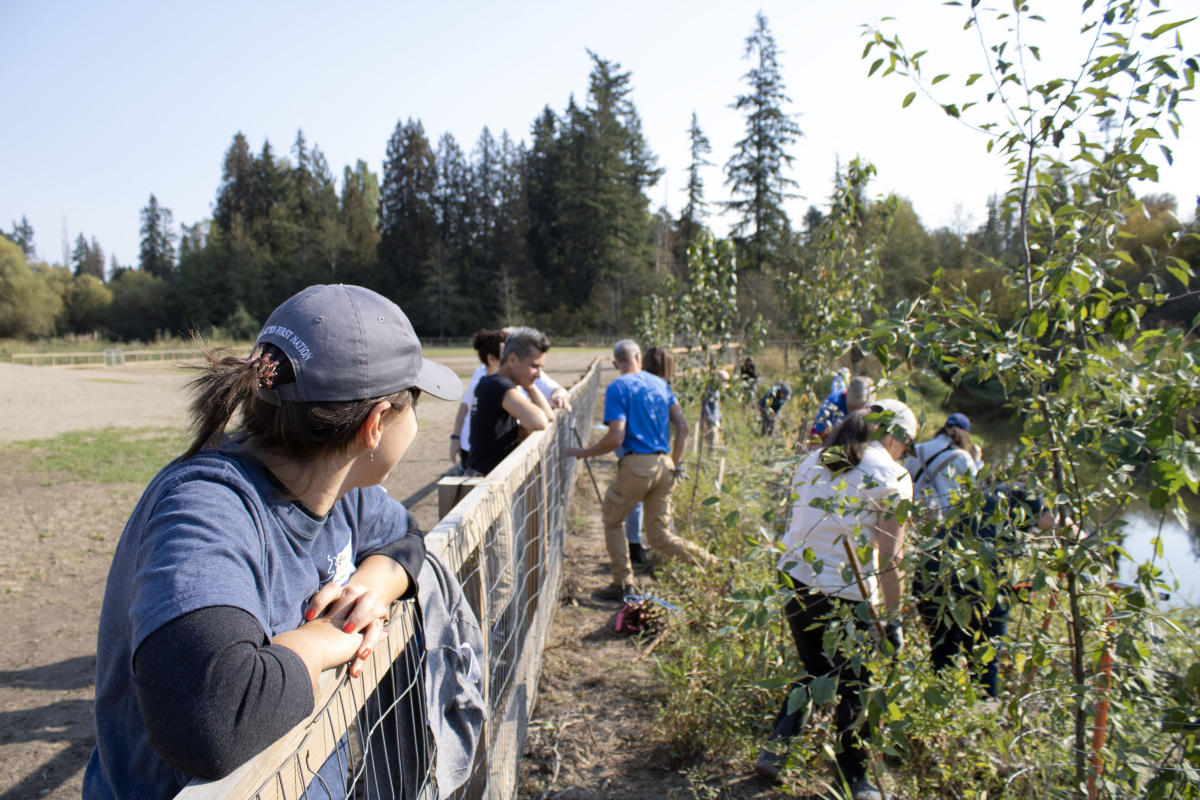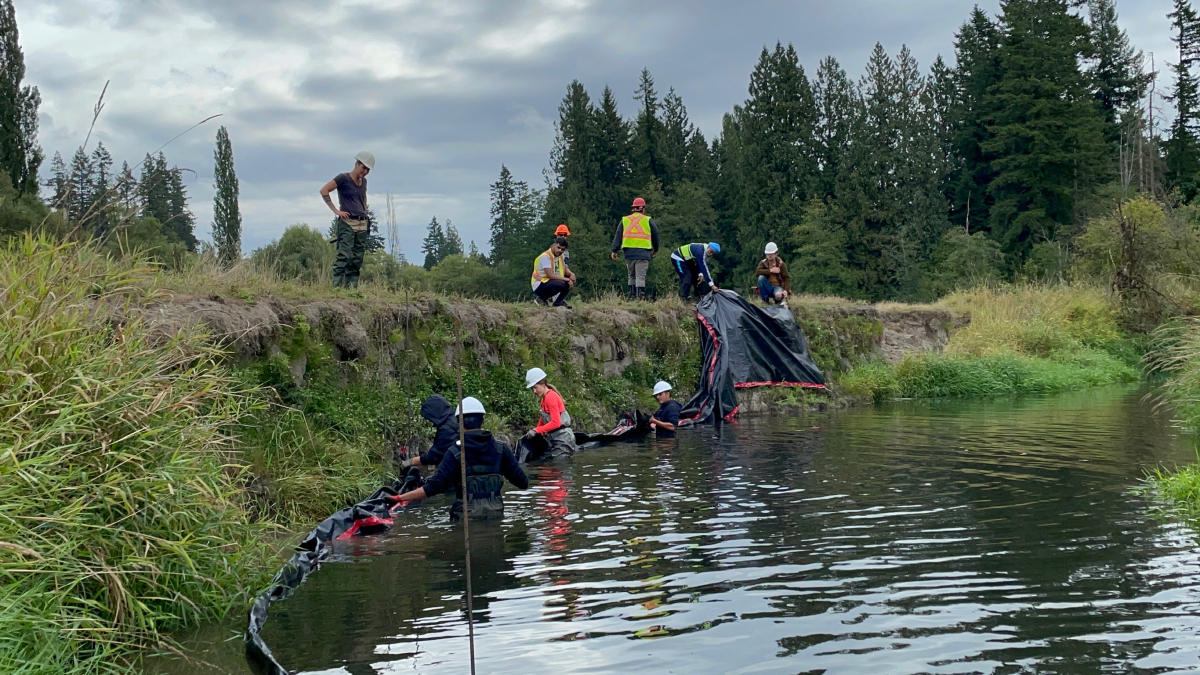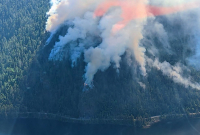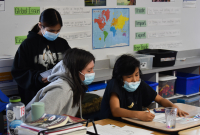Support strong Canadian climate journalism for 2025
The Fraser River, or stɑl̓əw̓, as it is called by the Kwantlen and Katzie First Nations, is under siege.
Climate change is warming its waters, aquatic species are suffocating from supercharged plant growth fed by fertilizer runoff from agriculture, and the invasive pine beetle epidemic is decimating forests, allowing more pollutants to enter the B.C. river. As the water heats, the salmon return has plummeted, an alarming indicator that the health of the stɑl̓əw̓ is declining and, with it, the health of the communities and First Nations that have always relied on the river.
Among the many efforts underway to restore the river’s watershed is the Rivershed Society of B.C.’s Foodlands Corridor Restoration Program, which was recently honoured with an Edge Prize. The award celebrates environmental solutions that draw on rural, Indigenous and traditionally marginalized communities as sources of inspiration. Rivershed is connecting adjacent parcels of privately owned land to create a natural corridor of wetlands and riparian areas along the stɑl̓əw̓ and its tributaries. Much of this land is currently farmed, which adds to the degradation of wetlands and riparian areas. Once created, these natural corridors will become healthy, functioning ecosystems that can better support salmon and other species at risk in the Fraser River watershed.
Foodlands uses a “two-eyed seeing” approach that integrates Indigenous knowledge and ecology with western science. Currently, Rivershed is creating a Foodlands corridor in Langley on a tributary of the stɑl̓əw̓, the sc̓e:ɬxʷəy̓əm (Salmon River). The sc̓e:ɬxʷəy̓əm is in the shared territory of the Kwantlen, Katzie, Semiahmoo and Matsqui nations. The program is working to restore degraded habitat along the sc̓e:ɬxʷəy̓əm that is home to numerous species at risk, such as Pacific salmon. The restoration work involves removing non-native species, replanting endemic plant species, building bat boxes where these species can safely roost and care for their young, stabilizing the banks along the river to prevent erosion and creating off-channel habitat made up of streams and wetlands that connect to the sc̓e:ɬxʷəy̓əm.

Species monitoring is showing positive signs at some of the restoration sites along the sc̓e:ɬxʷəy̓əm. Twice a year, Foodlands workers return to the site with biologists to conduct species monitoring and each time, they’ve found coho salmon in the restored marshes and off-channel habitat they’ve created.
“Historically, conservation and restoration haven't always taken into consideration cultural reclamation as being a key and an integral part of ecosystem restoration,” said Lara Volgyesi, project consultant for Foodlands. “The Foodlands program incorporates cultural and ecological restoration.”
For the award-winning program, Rivershed has collaborated with First Nations knowledge keepers to better understand the species that are nutritionally and spiritually valuable to them. Indigenous ways of knowing acknowledge that humans are part of a healthy, functioning ecosystem, too. Therefore, Rivershed aims to restore ecosystems along the sc̓e:ɬxʷəy̓əm that can continue to provide food and resources to the First Nations communities that have long used it to fish and travel. The health of communities along the sc̓e:ɬxʷəy̓əm is considered part of a healthy ecosystem.
“When it comes down to it, people are part of the ecosystem,” said Emily Pearson, co-ordinator of the Foodlands program. “Once we understand that we are a part of that system and that we have relationships with the land and with plants and wildlife, we can really approach conservation and restoration in a much more meaningful way.”
Kelly Yates, a Kwantlen First Nation elder and member of the Foodlands team, started fishing on the sc̓e:ɬxʷəy̓əm with his grandfather when he was about eight years old. Now, he fishes for salmon on the stɑl̓əw̓ to feed his family, Kwantlen Nation and other First Nations that do not have the ability to fish. For Yates, the stɑl̓əw̓ is the most important river in the world — it is how he and his community sustain their lives.
Each spring, Yates and other members of Kwantlen Nation fish for Chinook salmon, or spring salmon, as he calls them. This spring, Yates is still waiting for the Chinook to return to the stɑl̓əw̓. In May, high temperatures quickly melted snow at higher elevations and caused a sudden increase in the flow. A few weeks later, the height of the stɑl̓əw̓ has dropped nearly 10 feet, according to Yates, due to the continuous dry conditions. He speculates these sudden changes to the river’s flow are causing a delay in the Chinook salmon migration.
The stɑl̓əw̓ is changing, and Yates is witnessing the impacts of these changes first-hand. In recent years, when cleaning the fish he has caught, Yates has come across an increasing number of diseased salmon. He worries the salmon he is able to catch may not be safe to eat. Participating in the Foodlands Corridor Restoration Program is important to Yates; it feels good to know he is doing everything he can to protect the salmon and the river that means so much to him and his community. In one of the habitats he helped restore, Yates saw a coho salmon using the channel he built to return to the sc̓e:ɬxʷəy̓əm from an adjacent stream.
“It’s been gratifying, to say the least,” said Yates. “We're doing a fraction of the work [that’s needed] to keep our salmon safe, but if it saves one fish, that’s one more than if I was [doing nothing]. As long as I'm happy with what I'm doing within my own soul, then that's what's important to me.”

One of the most difficult challenges of this program is incorporating the views of others, such as farmers and agricultural landowners, whose colonial practices on the land have historically harmed the ecosystems and First Nations communities along the sc̓e:ɬxʷəy̓əm. To create resilient ecosystems along the sc̓e:ɬxʷəy̓əm, Foodlands considers how both western and Indigenous ways of growing, hunting and fishing for food can function within a healthy ecosystem.
“One of the early challenges we faced was that one of the participating landholders had a fear of potentially losing his rights to the land if he allowed us to do the restoration work,” said Volgyesi. "In a very short amount of time, he gained an understanding that we're all connected and that this isn't necessarily his land in the sense that there's other people and species [that rely on it]. He soon realized that this restoration work was going to have a positive impact on everything.”
By involving First Nations and agricultural landholders, the Foodlands program is not only restoring connections between natural areas but the historically broken connections between communities that live along the sc̓e:ɬxʷəy̓əm. The hope is that both First Nations and agricultural landholders will work together to protect the river that runs through their communities and shapes so many aspects of their lives.
This story has been corrected to reflect that the B.C.’s Foodlands Corridor Restoration Program does not buy parcels of land to create a natural corridor of wetlands and riparian areas. Rather it seeks permission from private landholders.






Comments
The work of the Rivershed Society of B.C.’s Foodlands Corridor Restoration Program to restore the ecological and cultural health of the stɑl̓əw̓ is inspirational and much needed. This kind of eco-cultural restoration is needed throughout the watershed of the stɑl̓əw̓. Conservation and restoration of the stɑl̓əw̓ watershed will need to focus on forest/timber management which is a major, likely the largest issue degrading water, habitat, and overall ecological health of the stɑl̓əw̓. The mountain pine beetle epidemic has actually had very little impact on the health of the stɑl̓əw̓, particularly compared to timber exploitation. The way that industrial forestry is done throughout BC and beyond degrades and often destroys the natural ecosystem composition, structure, and function necessary to maintain healthy salmon habitat and overall ecological integrity of the stɑl̓əw̓.